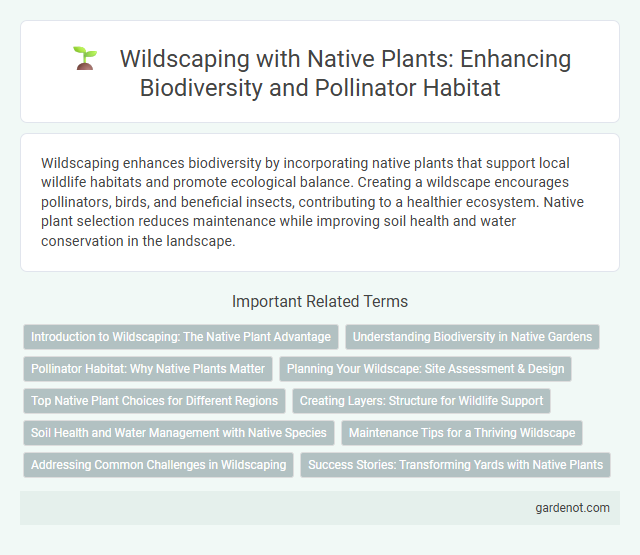Wildscaping enhances biodiversity by incorporating native plants that support local wildlife habitats and promote ecological balance. Creating a wildscape encourages pollinators, birds, and beneficial insects, contributing to a healthier ecosystem. Native plant selection reduces maintenance while improving soil health and water conservation in the landscape.
Introduction to Wildscaping: The Native Plant Advantage
Wildscaping leverages native plants to create sustainable, low-maintenance landscapes that support local ecosystems and enhance biodiversity. These plants, adapted to regional soil and climate conditions, require less water and fertilizer, reducing environmental impact and promoting pollinator habitats. Incorporating native species in wildscaping fosters a resilient garden that thrives naturally while contributing to wildlife conservation.
Understanding Biodiversity in Native Gardens
Wildscaping enhances biodiversity by incorporating native plants that support local ecosystems and provide habitat for indigenous wildlife. These gardens increase pollinator populations, improve soil health, and contribute to ecological balance by preserving native flora and fauna. Understanding the specific native species best suited for a region ensures a thriving and sustainable natural environment.
Pollinator Habitat: Why Native Plants Matter
Native plants play a crucial role in wildscaping by providing essential habitats for pollinators such as bees, butterflies, and hummingbirds. Their co-evolution with local pollinators ensures rich nectar and pollen sources that support biodiversity and enhance ecosystem resilience. Incorporating native species in gardens increases pollinator populations, promoting plant reproduction and sustaining food webs in the environment.
Planning Your Wildscape: Site Assessment & Design
Site assessment for wildscaping involves evaluating soil quality, sunlight exposure, and existing vegetation to select native plants that thrive in the local ecosystem. Designing your wildscape requires mapping water flow, identifying wildlife habitats, and incorporating diverse plant layers to support pollinators and bird species. Effective planning maximizes biodiversity, enhances ecological balance, and reduces maintenance by using native flora adapted to regional conditions.
Top Native Plant Choices for Different Regions
Wildscaping enhances biodiversity by using native plants perfectly adapted to local climates and soil conditions. Top native plant choices vary by region, such as purple coneflower and black-eyed Susan in the Midwest, manzanita and California poppy in the West, and southern magnolia and coral honeysuckle in the Southeast. Selecting region-specific natives supports pollinators, conserves water, and promotes ecological balance.
Creating Layers: Structure for Wildlife Support
Creating layers in wildscaping enhances habitat complexity by incorporating ground covers, shrubs, and canopy trees that provide diverse shelter and food sources for wildlife. Native plants arranged in vertical stratifications promote nesting sites, foraging opportunities, and protection for birds, insects, and small mammals. This structural diversity increases ecosystem resilience and supports pollinator populations essential for native plant reproduction.
Soil Health and Water Management with Native Species
Wildscaping with native species enhances soil health by promoting natural microbial activity and improving organic matter retention, which reduces erosion and nutrient runoff. Deep-rooted native plants increase soil aeration and water infiltration, optimizing water management and reducing the need for irrigation. This sustainable approach supports local biodiversity while maintaining balanced soil moisture levels and mitigating flooding risks.
Maintenance Tips for a Thriving Wildscape
Maintaining a thriving wildscape requires regular monitoring of plant health and selective pruning to promote native species growth and biodiversity. Incorporating organic mulch helps retain soil moisture, suppress weeds, and improve nutrient cycling essential for native plants. Encouraging habitat-friendly practices like avoiding pesticides and providing native pollinator habitats ensures long-term ecosystem balance in wildscaping gardens.
Addressing Common Challenges in Wildscaping
Wildscaping addresses common challenges by prioritizing native plant selection, which enhances local biodiversity and reduces maintenance requirements. Utilizing drought-tolerant species and improving soil health through organic mulching minimizes water usage and supports resilient plant growth. Incorporating diverse plant layers and natural pest control methods helps manage invasive species and promotes a balanced, sustainable ecosystem.
Success Stories: Transforming Yards with Native Plants
Wildscaping projects using native plants have revitalized urban yards by enhancing biodiversity and reducing water consumption. Homeowners in regions like the Pacific Northwest report increased visits from pollinators such as bees and butterflies after incorporating species like red-flowering currant and Oregon grape. These success stories demonstrate how native plant landscapes not only support local ecosystems but also create sustainable, low-maintenance outdoor spaces.
Wildscaping Infographic

 gardenot.com
gardenot.com